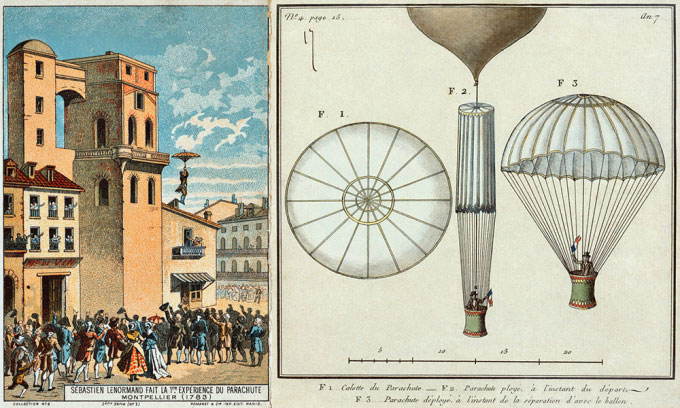The world's first successful parachute jump
Louis-Sébastien Lenormand made the first successful parachute jump from a 26 m high tower in Montpellier, France, in 1783, paving the way for the development of parachuting.
On December 26, 1783, a crowd gathered outside an observatory in Montpellier, a French city near the Mediterranean coast. The observatory is housed in the medieval Tour de la Babotte , one of only two remaining towers from the time when Montpellier was surrounded by walls. The structure, about 26 meters high, was used to study astronomical phenomena such as eclipses.

Illustration of Louis-Sébastien Lenormand's parachute jump at the Tour de la Babotte (left) in 1783 and André Garnerin's parachute design in 1797 (right). (Photo: Amusing Planet).
But on that December afternoon, the Tour de la Babotte tower was being used for a completely different purpose. Inventor Louis-Sébastien Lenormand , the son of a watchmaker, was preparing to perform a demonstration in front of a crowd.
Lenormand developed a device that allowed people to jump from burning buildings and land safely without injury. His device consisted of two large umbrellas attached to a solid wooden frame. Lenormand practiced this jump for a long time from lower heights - from the branches of elm trees. He also tested the device on animals before he felt confident enough to try it on himself.
Right on time, Lenormand appeared at the top of the tower. He waved to the increasingly excited crowd, then grabbed the handle of the giant umbrella, jumped down and landed successfully.
Lenormand did not invent the parachute, but he was the first to believe and risk his life on an idea that had existed for thousands of years. The earliest written records of parachutes are fictional. The Western Han Dynasty historian Sima Qian recounted the story of Shun, a mythical Chinese emperor who escaped his cruel father by climbing to the top of a tall granary and jumping to safety by grabbing two bamboo hats.
The oldest depiction of a parachute appears in an anonymous manuscript from the 1470s in Italy, depicting a man grasping a horizontal frame attached to a conical canopy, suspended in mid-air.
A decade later, Leonardo da Vinci sketched a more sophisticated parachute design, in which the canopy was stretched by a square wooden frame instead of a cone. The sketch was accompanied by a description: "If a man has a linen tent with the openings sealed, about 7 meters wide and 7 meters deep, he can jump from a great height without being injured."
Croatian inventor Fausto Veranzio (1551 - 1617) studied da Vinci's parachute sketches, retaining the square frame but replacing the canopy with a sail-like piece of fabric, finding it more effective at slowing the fall. In his parachute design, titled Homo Volans (Flying Man), Veranzio depicts a man parachuting from a tower, possibly the St Mark's Campanile in Venice.
The drawing has led some historians to believe that Veranzio, then 65 years old and seriously ill, actually tested his design by jumping from the bell tower of St Mark's Campanile. However, the lack of written evidence suggests that this event did not actually take place, and that the drawing is simply a simulation.

Design drawing of a parachute named Homo Volans (Flying Man). (Photo: Amusing Planet).
Two years after Lenormand's parachute jump in Montpellier, he coined the word "parachute" , from the Italian prefix "para" , meaning "against", and the French word " chute", meaning "to fall", to describe the practical function of the device.
After Lenormand's demonstration, parachute design evolved rapidly. In 1785, the same year Lenormand coined the word parachute, Jean-Pierre Blanchard demonstrated the parachute as a means of safely landing from a balloon using a dog. In 1793, Blanchard had the opportunity to test the reliability of the parachute himself when his balloon tore. Blanchard also developed a collapsible parachute made of silk instead of linen stretched over a wooden frame. In 1797, André Garnerin made the first jump in a "frameless" parachute covered in silk.
In the early 20th century, Charles Broadwick introduced two important improvements to the parachute. He packed the parachute in a backpack and deployed it using a static line attached to a balloon. When Broadwick jumped from the balloon, the static line stretched, pulling the parachute out of the backpack, and then snapping. This integrated, backpack-mounted system became standard on all modern parachute systems. Today, paratroopers still use static line parachutes.
- The first one jumped out of an airplane at an altitude of 25,000 feet without a parachute
- Nearly die with a free fall with
- The parachute system helps planes in distress land safely
- Why does the passenger plane have no parachute jump?
- An Austrian will fly faster than sound
- The 'wings' take the paratroopers away 200 km
- Mysterious person flies faster than Airbus 320?
- Tangram Smart Rope: Smart jump rope, integrated LED ring counting
- American 3D robot design know how to transform and jump high
- NASA tested parachutes for the Mars mission,
- The truths always amaze you about the biological world
- Images can 'jump' out of 3D TVs
 The most famous scientific failures in history
The most famous scientific failures in history Mysterious genius mechanic and the machine froze time
Mysterious genius mechanic and the machine froze time The son carries the 'bad gene' of genius Albert Einstein
The son carries the 'bad gene' of genius Albert Einstein Isaac Newton
Isaac Newton